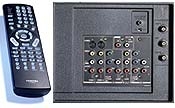Are You Ready for Some HDTV? Page 2
 Toshiba 50HX81 With a screen that's smaller than the other two sets' by 3 inches, Toshiba's 50-inch 50HX81 ($3,200) made up for any size disadvantage with a crisp picture and a ton of useful features. I also thought it had the best styling of the group, with the front-panel controls hidden beneath a flip-up door alongside an A/V input. Aside from the Toshiba logo and power LED, there's nothing to distract from the set's streamlined appearance. At 213/4 inches deep, the 50HX81 is also fairly slim, allowing you to squeeze it into spaces that you probably thought couldn't hold an RPTV.
Toshiba 50HX81 With a screen that's smaller than the other two sets' by 3 inches, Toshiba's 50-inch 50HX81 ($3,200) made up for any size disadvantage with a crisp picture and a ton of useful features. I also thought it had the best styling of the group, with the front-panel controls hidden beneath a flip-up door alongside an A/V input. Aside from the Toshiba logo and power LED, there's nothing to distract from the set's streamlined appearance. At 213/4 inches deep, the 50HX81 is also fairly slim, allowing you to squeeze it into spaces that you probably thought couldn't hold an RPTV.
The 50HX81 can display 1080i-format HDTV programs. Other features include a glare-resistant protective shield, automatic convergence for its three CRTs (cathode-ray tubes), and a built-in line doubler with 2:3 pulldown to eliminate the artifacts that can result when a 24-frame-per-second (fps) film source is transferred to 30-fps video. An additional perk that could come in handy if the set is placed in a busy family room is an ambient-light sensor - the set automatically adjusts picture contrast according to the brightness of its environment (you can defeat this if you prefer).
There's a generous number of A/V inputs, including two sets of wideband component-video jacks so you can connect both an HDTV tuner and a progressive-scan DVD player. In addition to a full-screen display mode for high-def programs and anamorphic widescreen DVDs, it has four modes for standard 4:3 programs: Normal, which displays the image at full height in the center of the screen with gray panels on either side, and three TheaterWide modes that blow up or stretch the image to various degrees. The TheaterWide 2 and 3 modes let you adjust the image position both horizontally and vertically - useful if a foreign film's subtitles ever get lopped off.
The fully backlit keypad on the Toshiba's large, well laid-out handset is a welcome touch so you won't be left fumbling for the mute button in the dark. Another cool thing about the remote is that you can easily change the TV's input or screen mode by pressing the Input or Picture Size key. An onscreen menu pops up with numbered options, which you select by pressing the corresponding button. The remote can be set up to control up to five components from different manufacturers besides the TV.
The 50HX81 offers a great many setup options. In addition to a Preference mode that lets you save custom picture settings for each of the TV's inputs, there are three picture presets - Movie, Sports, and Standard. Selecting Movie has the advantage of defeating the set's scan-velocity modulation (SVM) circuit, which is designed to visually pump up the edges of objects in images. However, the preset has an overly high sharpness setting that can't be modified using the TV's standard controls. So unless you plan on having the set professionally calibrated, you'll be better off selecting the Preference mode and making your own adjustments.
Toshiba has joined a handful of other RPTV manufacturers, including Sony and Hitachi, in offering automatic convergence alignment for the set's red, green, and blue CRTs. This feature, which Toshiba calls Touch Focus, should in theory deliver perfect alignment with a single button push. However, like other auto-convergence systems I've tested, Touch Focus did a less-than-perfect job. On the plus side, Toshiba also provides a nine-point manual convergence adjustment to correct some of the automatic feature's shortcomings.













































